Physical training methods have certainly changed a lot over the centuries—and most of those changes have been absolutely wrong. It’s well known to any serious physical culturist that the state of modern fitness training is dismal. Just look at the rates of obesity in the developed world, and then ask yourself if it counts as “development” to move towards a dysgenic state.
Philosophy aside, I will often say to the people I train that “worthwhile development in physical culture stopped around 1905” (the year that Thomas Inch invented the plate loading barbell), and I stand by that, with the exception of technical advice on the traditional lifts—and most of that in recent years has come from the states of the Former Soviet Union. I will admit that I have faced resistance from some over my “antiquated” views.
Speaking of the middle years of the Edwardian Era, I have recently come into the possession of a “Universal Fitness Test”, published in 1902, and written by Dudley Sargent, at the time the director of the Harvard University gymnasium. While the man can be criticized in some ways (namely, naming his son “Ledyard”), the question remains as to whether or not this 114 year old fitness exam has any merit.
The Introduction: A Brief Overview
The book doesn’t hesitate in giving you its wonderfully antiquated “Old Money WASP” verbiage: “‘To lift a heavier weight, throw further, to run faster, jump higher, to stay under water longer, to shoot further and with more accuracy than his comrades, is the burning wish of every youthful heart.’ To see this same desire in the hearts of adults, we must turn to those half-civilized peoples for whom those accoutrements are of surpassing value in the struggle for life.”
Ignoring the language that will surely clamp the anuses of SJWs shut, Mr. Sargent is right when he says that “…the practice of these exercises are of the greatest service in preparing young men for the struggles and trials of a business or professional career”—mens sana en corpore sano and all that.
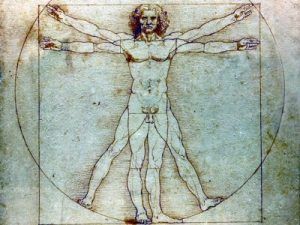
As a humorous aside, he also criticizes the modern fixation on professional sports—and the adulation these professional players-of-children’s-games receive—and bear in mind that this was more than 100 years ago:
“The Great Defect of Modern Day Athletics is that they are seen as an end unto themselves…those who excel in them receive praise and prestige. Why? …Physical perfection for its own sake is worthy of struggle”
The introduction then concludes with Sargent stating that the introduction of his test, and thus a competitive element to physical education, stimulated a much greater interest in physical training amongst his students.
The Test
The test was developed to have a series of criteria: it requires little equipment, it uses all large muscle groups and the CNS-PNS and cardiovascular system, it cannot be “gimmicked” with “tricks” or be made easier or harder depending on one’s body type, and it does not require the supervision of an expert.
The exercises are as follows:
Exercise 1 is the “elbows to knees,” an old-timey way of saying “the sit-up,” with the main difference being that the legs are kept flat in this. This exercise will of course work the abdomen, as well as the hip flexors as well.
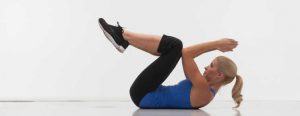
Scrunches are acceptable
Exercise 2 is the pull-up to work the back, shoulders, triceps, biceps, and forearms: Just grab onto a bar above your head and pull. The main thing that I would add is that he does not specify whether you should do palms anterior or posterior (or in layman’s terms, the pull-up or chin-up). I would say you should do both, I certainly do.
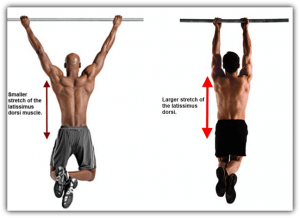
Exercise three is the classic push-up for the chest, arms, and shoulders: Keep your back straight and push up and down, touching your nose to the floor. Don’t worry about doing more advanced push-up variations like the one-handed push-up, the test doesn’t ask for it.
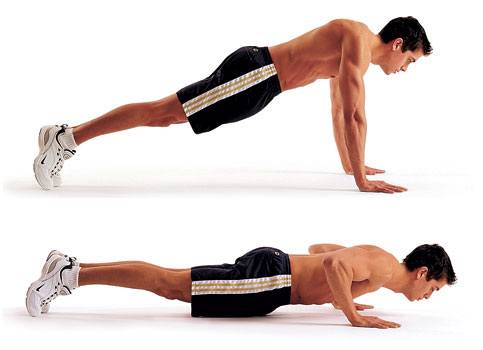
Exercise 4 are toe touches, a test more for flexibility of the hamstrings than strength: Place the feet together, lock the knees, and bend at the waist. This should be easy for anybody that isn’t morbidly obese.

Exercise 5: Heel and Calf Raises: Lock the legs and raise up on your tip toes, then do the same for the heels. This is a decent exercise for the ankles, feet, and calf muscles, and the heel raise trains the flexibility of the ankle in addition to the muscular work.

Exercise 6: This is an interesting exercise that some of you may not have done referred to as the “heel sit.” Hold the trunk upright, raise onto the ball of your feet, and squat down deep while extending your arms and fingers. Then rise up, bending your arms to your waist (See the picture below for clarification). Repeat.
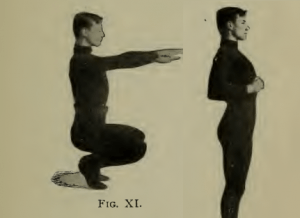
Grading the Test
The book advises that the test should be done as follows: 10 minutes are allotted for each individual, and the testee should do as many repetitions of each exercise as can be done in that time. The book advises that a “minimal” grade would be 7 sit-ups, 4 push-ups, 4 pull-ups, 12 toe touches, 5 heel and calf raises, and 18 “heel sits.”
Improvements that can be made
If this test becomes too easy (and as it is it isn’t very difficult, I imagine it will become easy quickly), you can easily modify it to be more difficult: Instead of sit-ups, try Roman Chair situps or V-Situps. Instead of standard push-ups, do one-handed push-ups, and ditto for the pull-ups. Instead of toe touches, try touching the hands flat upon the floor (or even doing the splits if you’re capable of it). Instead of calf raises, try doing pistol squats (which will test both calf strength and ankle flexibility simultaneously). The heel sits can remain “As is.”
So for the beginner or the advanced physical culturist that needs a concrete benchmark for fitness, you could do a lot worse than this Gilded Age educational curriculum.
Read More: A Nuclear Test Women Will Throw At You And How to Pass It
I wonder how many people can pass this test nowadays.
Nice piece. Speaking of back in the day, I wonder how many of us could pass the 8th Grade Final Exam for students in Salinas, Kansas, in 1895?
Grammar (Time, one hour)
1. Give nine rules for the use of Capital Letters.
2. Name the Parts of Speech and define those that have no modifications.
3. Define Verse, Stanza and Paragraph.
4. What are the Principal Parts of a verb? Give Principal Parts of do, lie, lay and run.
5. Define Case, Illustrate each Case.
6. What is Punctuation? Give rules for principal marks of Punctuation.
7-10. Write a composition of about 150 words and show therein that you understand the practical use of the rules of grammar.
Arithmetic (Time, 1.25 hours)
1. Name and define the Fundamental Rules of Arithmetic.
2. A wagon box is 2 ft. deep, 10 feet long, and 3 ft. wide. How many bushels of wheat will it hold?
3. If a load of wheat weighs 3942 lbs., what is it worth at 50cts. per bu, deducting 1050 lbs. for tare?
4. District No. 33 has a valuation of $35,000. What is the necessary levy to carry on a school seven months at $50 per month, and have $104 for incidentals?
5. Find cost of 6720 lbs. coal at $6.00 per ton.
6. Find the interest of $512.60 for 8 months and 18 days at 7 percent.
7. What is the cost of 40 boards 12 inches wide and 16 ft. long at $.20 per inch?
8. Find bank discount on $300 for 90 days (no grace) at 10 percent.
9. What is the cost of a square farm at $15 per acre, the distance around which is 640 rods?
10.Write a Bank Check, a Promissory Note, and a Receipt.
U.S. History (Time, 45 minutes)
1. Give the epochs into which U.S. History is divided.
2. Give an account of the discovery of America by Columbus.
3. Relate the causes and results of the Revolutionary War.
4. Show the territorial growth of the United States.
5. Tell what you can of the history of Kansas.
6. Describe three of the most prominent battles of the Rebellion.
7. Who were the following: Morse, Whitney, Fulton, Bell, Lincoln, Penn, and Howe?
8. Name events connected with the following dates: 1607, 1620, 1800, 1849, and 1865?
Orthography (Time, one hour)
1. What is meant by the following: Alphabet, phonetic orthography, etymology, syllabication?
2. What are elementary sounds? How classified?
3. What are the following, and give examples of each: Trigraph, subvocals, diphthong, cognate letters, linguals?
4. Give four substitutes for caret ‘u’.
5. Give two rules for spelling words with final ‘e’. Name two exceptions under each rule.
6. Give two uses of silent letters in spelling. Illustrate each.
7. Define the following prefixes and use in connection with a word: Bi, dis, mis, pre, semi, post, non, inter, mono, super.
8. Mark diacritically and divide into syllables the following, and name the sign that indicates the sound: Card, ball, mercy, sir, odd, cell, rise, blood, fare, last.
9. Use the following correctly in sentences, Cite, site, sight, fane, fain, feign, vane, vain, vein, raze, raise, rays.
10.Write 10 words frequently mispronounced and indicate pronunciation by use of diacritical marks and by syllabication.
Geography (Time, one hour)
1. What is climate? Upon what does climate depend?
2. How do you account for the extremes of climate in Kansas?
3. Of what use are rivers? Of what use is the ocean?
4. Describe the mountains of N.A.
5. Name and describe the following: Monrovia, Odessa, Denver, Manitoba, Hecla, Yukon, St. Helena, Juan Fermandez, Aspinwall and Orinoco.
6. Name and locate the principal trade centers of the U.S.
7. Name all the republics of Europe and give capital of each.
8. Why is the Atlantic Coast colder than the Pacific in the same latitude?
9. Describe the process by which the water of the ocean returns to the sources of rivers.
10.Describe the movements of the earth. Give inclination of the earth.
==================================
Looks like we’ve been deliberately dumbed down since 1895…doesn’t it now.
Theodore Dalrymple used something similar. He reproduced a letter written by an uneducated maid in the 1800s and demonstrated how superior it was grammatically to a letter that had recently been written a modern academic.
The difference was startling
Sad, isn’t it. Pretty soon kids will receive a college degree if they can successfully write out a three-line text message using accepted abbreviations for words, like: “LOL – u r so funny. Fuck my pussy after school? So good. OK c u later.”
Someone wrote “fuck off” on a high school exam here a few years ago and got a mark for it
You gotta be shitting me? I can see this – kids passing if they are able to recite the five taboo types of people. Racists, sexists, critical thinkers, homophobes, patriarchs.
http://news.bbc.co.uk/1/hi/education/7481715.stm
After reading that one, I am at a loss to describe just how far we have fallen as a species…I mean, I just can’t quantify it.
Self-sabotage on a historically unprecedented level
I mean…they pull this dumbing-down thing off, right. And simultaneously, they convince most of the population that conspiracy theorists are crazy. And all I can do is applaud, in the end, and say, “Mission accomplished.” Crying about it won’t do much. Too late for that. I admire the plot, and the execution of it, and I admire it for what it is, even though it’s sickening. Love it or hate it, it’s insidiously fucking brilliant.
Some high schools are allowing students unlimited extra credit opportunities. The student can basically choose their grade. A few high schools in Michigan were doing this. One high school in particular was recognized as one of the best in the state. Just reminded me of a music video where a cowboy keeps trying to shoot a tin can off a fence. He keeps missing, walks closer and closer, finally he just knocks it down with his hand.
Jesus. I mean, I don’t even have any words to express how ridiculous the whole thing is…
Indeed. I used to be a personal trainer and a lot of the mothers were clients of mine. They would go on and on about how great this school was and of course brag about their kids. I’m thinkin “ok, ok, cool.” This went on for a while until one of them told me with excitement, “yeah! and they let the student do as much extra credit as they want until they get an A!!!” The look on my face. “Whaaaaaaaat? Okay? What the?” Then of course I said, “so let me get this straight, if a student is getting an E, they can boost their grade with extra credit until they get an A or pass.” “Yes!” She says with excitement. She could suck a mean dick though.
Well I was getting upset there, until I found out she could suck a mean dick. I guess the flip-side of easy A’s in school, when it comes to women, is they wind up just being fucking easy (and talented where it counts). Thanks for showing me the positive side, there…it’s not all bad news.
“Uneducated” West Indian maid no less.
Would you mind sharing the link. It would be interesting to read such a comparison. Or at least the title of the article..
Skokal, on Wikipedia.
As a collector of antique paper ephemera, I’m forced to agree.
In real life if you heard me speak, I’d come across as a tractor driving hick. In a crowd of blue collar men, I’m the funny yet semi-quiet man.
I have to tone things down a bit, you see.
In the company of the “highly educated”, I let loose. I like making them feel…lessened. With a country boy accent. It’s a hobby of mine.
I’ve read letters from civil war recruits, non-officers, in their own handwriting that would make a modern PhD in English blush in ignorance.
It’s amusing in a personal way to make fun of how far we’ve fallen, but on a higher level I’m saddened that we’ve fallen this far.
The midwest has an accent?
Yes, I was raised in New York, and it wasnt until I left the US came to my current place of residence and met people from your region that I was made aware of what your people are actually like.
It’s not hard to make modern-day leftists and “academics” look poorly educated. I imagine that one reason for the high level of proficiency you saw in those Civil-war era enlisted men’s writing is the prevalence of the King James Bible in society back then. I’ve long noticed that most ostensibly educated Americans struggle to even read Tolkien, and I often have to tone down my vocabulary in conversation to be readily understood. I think this is largely because when I was a little kid, my Mom and Dad had us do bible study using the KJV, patiently explaining the vocabulary to us.
I struggled to read Tolkien, but not because of the language. It’s because the sudden shift from a plain and colloquial storytelling style in the beginning of the series to the somewhat overblown use an old-english style of writing designed to make the writing seem more “epic”. It would have worked great if the series had started that way but it was a bit jarring.
I imagine by “old-english” you mean something like “early modern English.” You’d be highly unlikely to understand much of anything from before the early modern period. Regardless, it seems that what I found beautiful and poetic, you found “overblown.” To each his own.
Reminds me of the guy a few years ago who wrote gibberish interspersed with leftist buzz words and slogans and sent it to a “post-modernist” critical journal — which published it as a serious article.
Can I get a link?
I can’t remember his name or the publication. I’m not sure what keywords would turn it up. Maybe postmodernism. Postmodern hoax. It was probably around 2012 but I’m not sure now.
I think the media quit mentioning it pretty quick.
I’ve been trying to remember the title and authors of a book by female scientists who were embarrassed about supposed science done by feminists. Like, the feminists claimed that if someone other than white men had first mathematically described gravity, then gravity would behave differently!
Skoko Affair. Well remembered
Skokal, I just found. Wikipedia.
Thanx…
That’s the beauty
The Victorians were smarter than us, study suggests
http://www.telegraph.co.uk/news/science/science-news/10053977/The-Victorians-were-smarter-than-us-study-suggests.html
They were less distracted by nonsense and more focused on things of importance.
Some of those questions require knowledge that isn’t common outside of Cornhusker Country though, others are oddly defined and some couldn’t be answered nowadays by the original answer key as the answers would be too radically different.
Unfortunately, this test indicates that in 1895 students were being fed propaganda and dumbed down politically as I seriously doubt that they would have accepted the truth about Lincoln, the first neocon and flaming crony corporatist.
Yep. A person will see both good and bad in this, no matter their perspective. That being said, a nation of mentally sharp citizens might be perceived as being more beneficial than a nation of drones who thumb-fuck the keypads of their cell phones. No matter how you break it down, we’re all in a state of outwardly imposed idiocy and servitude…
Well said. My father in law (rest in peace) had an 8th grade history test that would stump modern college students. I know, I found it in a box of things he owned after he passed away.
Any way I could get you to scan that? I actually want to write up a comparison on that and try to place it a grade level relative to current teaching.
Interesting article. I didn’t know Dudley Sargeant, but will surely try to acquire a copy of his book (perhaps there are fresher re-editions?). Anyway, I concur with Larsen that this era’s literature remains top quality to this day. In other languages, namely French, Italian and German, you can still read awesome books on individual exercise from the ’20s and the ’30s. The problem is they are rare and you’ll have to actively search for them.
As for the exercises suggested in this small selection, they cover pretty much all muscular groups and this can be a good basis for a “muscular fitness diagnosis”, to adjust your workouts from time to time.
thank you, Larsen.
There’s a lot of classic self-improvment lit from the same era by Wattles and Marden, et al. Much clearer thinking and writing for the most part than today.
I couldn’t pass a kindergarden fitness test.
Could you at least pass the cookies, then?
Sure thing.
Seriously?
I’m pretty unfit.
Then get fit.
Consistently work out every day.
You can find a free calisthenics course at livestrong.com, also you can start doing “convict conditioning”. It is a great series of progressive bodyweight exercises.
I am not lacking in good ideas, I am lacking in energy, for other reasons that matter to me. The problem will be solved in time.
Makes sense. Unfortunately physical fitness can sometimes have to take a backseat to work or other crisis events.
Yup.
Most body-weight conditioning (many call calisthenics), take little time, 10 or 15 minutes a day. Before the ubiquity of the interwebz, I bought a book that outlines a lot of common and uncommon exercises. For example, there are at least a dozen ways to do pushups, not counting one-handed styles. I take umbrage on a lot of ab exercises; you can’t use them to spot-reduce and the only way to really define abs is to get rid of Mr. Gut!
I know man. It’s the same with diets. The problem is not having good ideas, as I wrote above. If I was serious about it, I would easily know what to do. That’s not the issue. But I don’t wanna make a big fuss about it, my original comment was just meant to be humorous.
Ive heard the Wim hof method is very good.
Thanks, I heard of it too. Didn’t try it yet. Maybe I will.
It’s strange that here we are among men who would find this test laughably easy, but in america we are surrounded by multitudes of people that would pay money to not have to take such a test.
What’s funny is if you thought men wore formal wear like that in the gym for the photo shoot it wasn’t why they are dressed like that, they really dressed like that when they were at the gym. Apparently clothes for exercise wasn’t thought as much
‘Formal’ used to be considered Black/White Tie; a tuxedo. The dress pictured was considered informal. Now, ‘Formal’ is considered anything dressier than flip-flops and cargo shorts/t-shirts.
In my sleep. I can in a pinch act as a human car jack.
The question then is “do we live in a society where men in general can do this”.
The answer is a coin toss.
And that’s sad.
I honestly couldn’t. My only sport is walking to the cigarette vending machine
Meh back then memorizing was favored above all else without the existence of google and the internet, it’s really irrelevant. And I wouldn’t say people were smarter back then they were just more likely to put their thoughts into application because their survival depended on it. They also didn’t have television and social media to distract them.
It is a fact that people are getting dumber. Also, TV is more than just a distraction.
That being said, I find that wisdom is something found in oneself optimally through trials and hardships.
Neither do we look in ourselves anymore, largely due to the muddying of the self by entertainment, nor do we have hardships.
I’m surprised that passing a 1902 fitness test doesn’t somehow jumping in the boxing ring with a Marsupial.
BULLY!!
In all candor, fine article.
Anybody here read “Solitary Fitness” by ‘Charlie Bronson’? Bronson is one of the most notorious criminals in the UK and developed his bodyweight conditioning program while in solitary confinement. The book focuses on basic bodyweight exercises, which is all he had, given limited resources.
ISBN- 10: 1844543099
ISBN-13: 978-1844543090
Neat suggestion!
Book had very solid advice and was a fun read if I recall well.
For cardio. Opt for Kettlebell over running machine.
You can also use kettlebell as weight resistant and plus it won’t take up much space although you do need some ample space for kettlebell swings and snatches
If you don’t have barbell, get a sandbag and hoist over shoulder and do squats.
push up is free
For pull up bars, just get a good decent size pull up bar
and doing bodyweight squat is free.
In fact, the weakest weightlifter back in the day would put average man today in shame.
Where there’s a will there’s a way.
Speaking of education, Dudley was no schmuck, he got a MD in Yale Medical School.